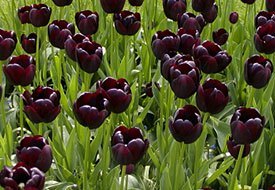Black tulips exist only in the imagination. In literature, for example, the quest for a dark-hued tulip figures in the 1850 novel, The Black Tulip by Alexander Dumas.
In this tale of love, murder and greed, the hero Cornelius Van Baerle grows a unique jet-black tulip that is stolen by a malevolent neighbor. Much deadly intrigue follows, and Van Baerle is jailed. Then as execution looms, he is saved just in time.
Swash-buckling romance aside, the black tulip cultivars we grow today are 20th century introductions – and they’re actually dark plum, purple or maroon, as truly black flowers are virtually unknown in nature.
Gardeners lust after the unusual
 ‘Queen of Night’ Tulips
‘Queen of Night’ Tulips
Flowers such as black tulips that are rare, even impossible, in nature have undoubted appeal.
For trendsetters, there’s cachet in creating ‘dramatic’ rather than merely ‘pretty’ effects in the garden.
Dark colors have sumptuous appeal, as color experts Sandra and Nori Pope, who gardened for a number of years at famed Hadspen House Garden in England, attest.
In their book, Color in the Garden, the Popes observe that unlike brighter colors, which reflect light, shades like deep plum absorb light, drawing us into “an atmosphere of mysterious opulence.”
Popular dark-colored tulips
 Dramatic contrast: ‘Queen of Night’
Dramatic contrast: ‘Queen of Night’
tulips with red tulips
Dark, almost black tulips offer the potential for stunning and dramatic combinations.
The most popular cultivars are ‘Black Parrot’, a parrot type with deep purple feathered petals, introduced in 1937, and the single late-flowering ‘Queen of Night’, a velvety maroon, still said to be the darkest tulip available. It made its debut in 1944.
Black Hero, is a double late tulip in deep wine, almost black, red; several catalogues refer to it as the double ‘Queen of Night’.
Plant combinations with dark tulips
At Hadspen Garden, for example, the Popes combined ‘Queen of Night’ tulips with the silver-gray foliage of Artemisia ludoviciana ‘Valerie Finnis’ and the bronze foliage of emerging peonies to create a rich tapestry.
You can also try pairing ‘Black Parrot’ tulip with white bleeding heart. It also goes well with the chartreuse-flowering perennial, cushion spurge (Euphorbia polychroma), which blooms at the same time.
Both combinations are terrific and all three can even be grown together. Of course, ‘Black Parrot’ tulip also goes splendidly with its white counterpart, ‘White Parrot’.
Another attractive combo – billed “stunning sophisticates” in one bulb catalogue – is pairing ‘Queen of Night’ with the lily-flowered tulip, ‘White Triumphator’.
For another exotic late-blooming combination try the lily-flowered tulip ‘Burgundy’, a deep purplish violet, with its luminous orange counterpart ‘Ballerina’.
More dark-hued tulips to try:
- African Queen: Triumph tulip in dark glowing ruby-red; the base inside is primrose yellow, edged with purple
- Black Diamond: Single late tulip with deep mahogany petals
- Arabian Mystery: Triumph type; rich violet purple with silvery-white at the edges of the petals
More Bulb Information
When
in fall to plant bulbs? Hint: not too early
Bulb
planting: How and where to plant, squirrel solutions
Designing
with spring bulbs: How to get more bang from your buck




